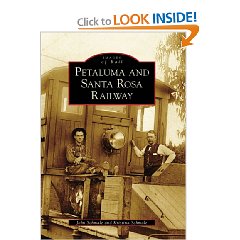Story from John Vonderlin
Email John ([email protected])
Story from John Vonderlin
Email John ([email protected])
Story by John Vonderlin
Email John ([email protected])
Hi June,
Do you remember my posting about”Gumby,” the largest Gumboot Chiton, I had ever seen washed ashore. Though dead, it was in amazingly good shape, with its tentacles intact, unlike most I see. Well, it wasn’t quite a case of a “Butterfly emerging from its pupae, more a butterfloid emerging from its poopa, when I recently dug it up from the bucket of dirt I had buried it in. As you can see from the pictures, Nature’s recyclers hadn’t quite done their job completely.
I don’t usually bring potential food for shore critters home, but was curious about the size of the plates in this giant. I now can compare its plates to the “bleached bones” of its compatriots I have previously collected. My initial opinion is that there are much bigger Gumboots out there, as a few of the plates I have are bigger then Gumby’s. Enjoy. John
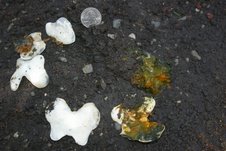
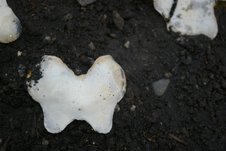
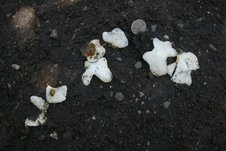
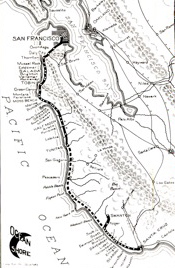
If you cannot read the names of the towns/places, here they are, north to south along the coastline. A few names are new to me, and I note that Torquay is not mentioned.
San Francisco
Omondaga [Please read John’s email below]
Daly City
Thornton
Mussel Rock
Edgemar
Salada
Brighton
Vallemar
Rockaway
Tobin
Green Canyon (see story below)
Montara
Farallone
Moss Beach
Marine
Princeton
North Granada
GRANADA
South Granada
Miramar
Half Moon
Arleta
Purisima
Lobitos
TUNITAS
San Gregorio
Pescadero
Pebble Beach
Pigeon Point
New Years Pt,
Waddell Beach
Scott
Scott (repeated again)
Davenport Landing
Blue Gum
Davenport
Lidell
Yellowbank
Lagos
Enright
SCARONI
Parson’s Beach
WilderR
Rapett
Then we’re out of San Mateo County and into Santa Cruz, so I’m not going to mention anything there, not much anyway.
Other moew familiar San Mateo County places named to the east of the Pacific Ocean include:
San Bruno, San Mateo, ,Redwood, Palo Alto, La Honda, Bellevale, Big Basin, Swanton and Folger
Very interesting, isn’t it?
———-
From John Vonderlin
Email John ([email protected])
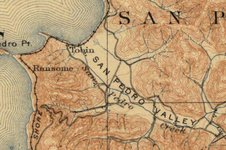
[Remember, I had a pamphlet about a new Coastside town called Torquay? I’d never heard of the place and don’t even remember who gave me the pamphlet which I am now digging about for. Well, John Vonderlin has new information that clears up the location of this mysterious “city” that never appeared. Also, here are some web definitions for Torquay, please click here.]
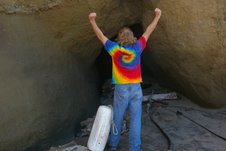
Says John Vonderin: As long as I’m writing about dreams dashed by the ’06 Quake, I should return to this small item. A while ago you posted the cover of a pamphlet for the planned city of Torquay, near Ano Nuevo. It was quite amazing, with Venice-like features; a hexagonal design, waterways, a lagoon, even a waterfall, all designed to accentuate the natural features of the area, rather then dominate them. Unfortunately, other then your pamphlet posting and an online mention of a post office of that name, I could find little else.
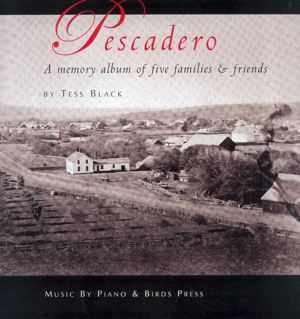
Story is dated 1857
From John Vonderlin
Email John ([email protected])
[Note: Pescadero was originally part of Santa Cruz County, but from what I, June, understand, the incoming tides made it difficult to the get the county seat. In the 1860s a petition was circulated to make Pescadero part of San Mateo County, a much easier and safer trip over the mountains.]
From John Vonderlin
Email John ([email protected])
Story from John Vonderlin
Email John ([email protected])
Story from John Vonderlin
Email John ([email protected])
BUTTER CONTAINS TOO MUCH MOISTURE
A.B. Cavalli, Rancher, Violated Pure Food Law” MENLO PARK March 4. –For “his violations of the pure food laws A.B. Cavalli, a La Honda rancher, has run afoul of the government inspectors, with the result that he was fined $1,025 which was later reduced to $23. Cavalli has a large dairy at La Honda and for some time has been shipping 300 pounds of butter a week which has contained from 22 to 30 per cent moisture instead of the 15 per cent allowed by law. On please of ignorance and first offense Cavalli’s fine was reduced from the original set
Story from John Vonderlin
Email John ([email protected])
|
Hi June, This article, from the February 2nd, 1865, issue of “The Daily Alta,” preceded the two articles, “Santa Clara and Santa Cruz Oil Lands #1 and #2,” and describes the excitement about black gold sweeping the nation. Enjoy. John
Petroleum Excitement in California
A petroleum excitement is prevalent in California, although it is evidently far from its climax. At every corner of Montgomery street, between California and Washington streets, squads of men daily, during business hours, distill petroleum. Everybody has a friend interested in petroleum, who communicates to him confidentially the brilliant prospects of bis enterprise. Nearly every newspaper has an item about petroleum. From Humboldt to Saa Diego the motto of every pilgrim and the chorus of every song is “petroleum,” and the word has a far sweeter sound, and suggests a far more successful fate than “excelsior.” True, tbe excitement is not confined to this State. The whole civilized world appears to be affected. The fortunes made bjr coal oil in Pennsylvania are enough to fix the attention of all speculators and to awaken the envy even of Californians. Neither the gold of the State nor the silver of Nevada has made so many millionaires. It is, indeed, doubtfnl whether in the history of the world, there is elsewhere any record of so many great fortunes being obtained so speedily, with so little labor, with investments of money so small, and without the spoliation of any one. It is said that the coal oil produced by Pennsylvania is now worth more annually than all the yield of its great iron and coal mines, which have to be worked at vast expense, whereas the coal oil flows out in a perennial stream from many wells, with little expense save barreling. In late numbers of the New York and Philadelphia papers we see a number of advertisements of petroleum companies, giving notice of dividends, varying from one to five percent, per month, on the nominal stock which, in many instances, is double the actual capital paid in; and though not a few of these companies bought their lands at high prices afi«r the wells had been bored by individuals who made fortunes by selling. No State in the Union has so many petroleum springs as California. Oil springs existed at many places in Pennsylvania and Virginia, but they couM not compare in number or abundance with those of this coast. Scarcely a county near the coast, from Oregon to Lower California, that is without them. In Eel Eiver Valley there are several of considerable size; near Pescadero, Santa Crnz, there are half a dozen; and south of Monterey Bay, thousands of acres are covered with the asphaltum formed by the drying up of the oil which has come to the surface mixed with dirt, and has lain under a burning sun for nine months in the year. The principal deposits of asphaltnm, including those from which large supplies for the roofs and sidewalks of San Francisco are obtained, are mentioned in the Pacific Railroad Reports, and in Hittell’s ” Resources of California, and these are probably the largest deposits on this continent. It is to be presumed that when the oil can rise from its deep chambers in the earth, through a straight and clean pipe, the flow will be abundant aod of good quality. People are confident of success, and capitalists have invested their money. Not less than a quarter of a million in gold, if report be true, has been spent in buying petroleum lands along the southern coast, and men are now engaged in boring at half a dozen different points.
|
[Note from June: One of the best books I have read on the history of oil is called: “The Prize, The Epic Quest for Oil, Money & Power” by Daniel Yergin, for more information, please click here

Story from John Vonderlin
Email John ([email protected])
Fred Sarcander and Charles F. Brandenstein were on the San Gregorio creek in San Mateo county. Up to the end of last week Brandenstein had planted 260,000 trout fry in the streams of that county for the Ocean Shore railroad company. The fish were distributed as follows: Frenchman creek, 20,000; Pedro, 20,000; Dennison and Ward, 20,000; Purissima, 40,000; Lobitas, 75,000; Tunitas, 40,000; San Gregorio, 70,000. W.A. L. Miller, Frank M. Smith and George A. Wentworth recently planted 100,000 steelhead fry from the Ukiah hatchery Sonoma creek for the California anglers’ association
Wow, thanks John for the great article. It ties in with a story I am developing about the station agent at Tunitas depot grumbling about having to plant the fish in the creek. It was from Ocean Shore Railroad engineer Adolph Seigel. Thanks very much.
